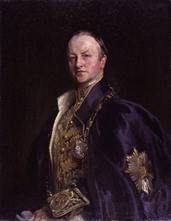

20th August 2022 (6 Topics)
Context
The Bardhaman municipality has decided to erect a statue of an erstwhile Maharaja Bijoy Chand Mahatab and his wife Radharani in front of the landmark Curzon Gate in the city.
About
- Burdwan’s iconic Curzon Gate, a heritage structure was built between 1902- 1903 on the occasion of the coronation of Maharaja Bijoy Chand.
- It was initially known as ‘Bijoy Toron’.
- Later it was rechristined as Curzon Gate after George Nathaniel Curzon, the Viceroy of India visited the royal palace in 1904.
- According to a section of the local residents, it bears the mark of the Maharaja’s ‘absolute loyalty’ to the British Empire.
- The Curzon Gate was declared a heritage site on 28 February, 2006 by the West Bengal Heritage Commission.

|
Important Fact The Ancient Monuments and Archaeological Sites and Remains Act, 1958 prohibits any construction within 100 metres of a historical building or structure accorded protection under the Law. However, Curzon Gate doesn’t have the ASI cover. |
Who was Lord Curzon?
- George Nathaniel Curzon (1859-1925)served as Under-Secretary of State for India (1891-1892), and for Foreign Affairs (1895-1898), before being appointed Viceroy of India in 1899.
- Curzon created
- a separate Muslim majority province of the North-West Frontier Province
- sent a British expedition to Tibet
- established a separate police service
- established the Archaeological Survey of India, in order to study and protect historical monuments

- As a staunch imperialist, he took a series of extremely unpopular measures, including:
- passing, the Calcutta Municipal Amendment Act in 1899, which reduced the number of elected representatives in the Calcutta Corporation;
- the Indian Universities Act (1904), that placed Calcutta University under government control,
- the Indian Official Secrets Amendment Act (1904) that reduced the freedom of the press even further
How and why did the partition of Bengal take place?
- Calcutta was the capital of the British Raj, and Bengal Presidency was one of the largest provinces in India, encompassing present day West Bengal, Bangladesh, Bihar, parts of Chhattisgarh, Odisha, and Assam.
- In July 1905, Curzon announced the partition of Bengal into two provinces.
- Muslim province: East Bengal and Assam, with a population of 38 million, was predominately Muslim
- Hindu province: Western province, called Bengal, was reduced to 55 million people, primarily Hindus.
- Protests began almost immediately after the announcement, with meetings taking place in more than 300 cities, towns, and villages across Bengal.
The consequences of the partition:
- Popular anger against partition had been brewing since the British announced their scheme, but grew into a stronger and more organized movement after it was implemented in 1905.
- In opposition to the partition, nationalist leaders organized a campaign of boycott of British goods and institutions, and encouraged the use of local products.
- After a formal resolution was passed at a meeting in Calcutta in August 1905, the Swadeshi movement began.
- Students were at the forefront of the movement, which was characterized by boycotts of British educational institutions and law courts, and large bonfires of imported cotton textiles.
- There was a surge in nationalist rhetoric, and the song ‘Bande Mataram’, set to music by Rabindranath Tagore, became the informal anthem of the movement.
- The Swadeshi movement and boycott was not restricted to Bengal, and spread to other parts of the country, including Punjab, Maharashtra, and parts of the Madras Presidency.
- A number of secret societies, such as the Anushilan Samiti of Bengal, sought to overthrow British rule through violent means.
- Revolutionary groups used bombs, attempted to assassinate colonial officials, and engaged in armed robberies to finance their activities.
- In 1905, Curzon resigned and returned to England after losing a power struggle with the commander-in-chief of the British Army, Lord Kitchener.
- The protests continued after his exit, and the colonial government in 1911 announced the reunification of Bengal, and the capital of the Raj was shifted from Calcutta to Delhi.
More Articles

